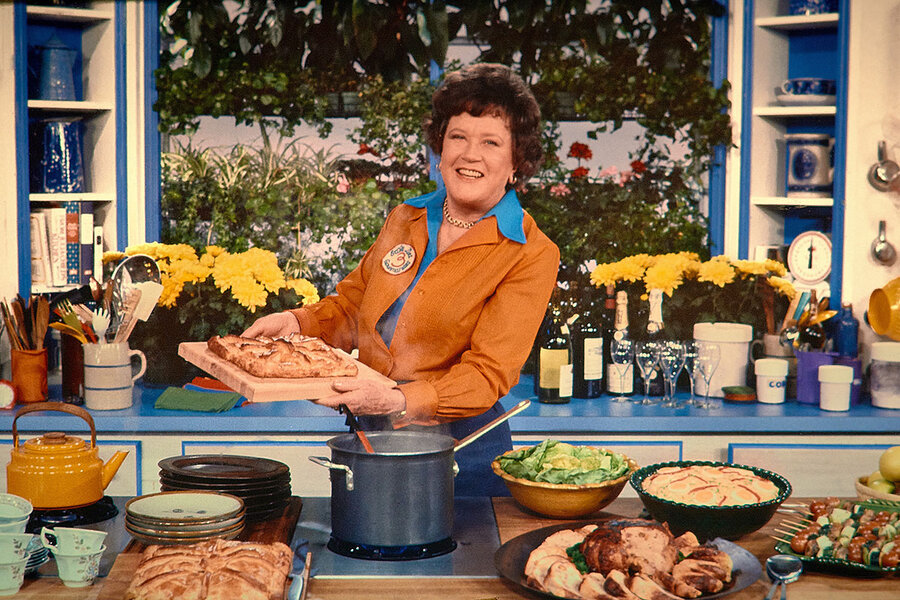A foodie delight, ‘Julia’ shows how one chef influenced America
Loading...
Early on in the new documentary “Julia,” about the famed culinary luminary Julia Child, she lets it be known that “I found that if people aren’t interested in food, I’m not very interested in them.” Certainly few people on the planet were more interested in food than Child, and, judging from this movie, few people are as interesting.
For those of us who grew up with her cooking shows on public television – a TV career that began in 1963 and lasted for decades – seeing her here in all her gawky eccentricity is good for the soul.
Like many others, I didn’t tune in to learn how to cook French cuisine. I didn’t even watch in order to savor the scrumptious close-ups of boeuf bourguignon or tarte tatin. (By the way, don’t see this documentary on an empty stomach.) What I looked forward to was simply watching Child do her thing in the kitchen in that unmistakable voice of hers – a kind of fluttery singsong pitched somewhere between a gasp and a whoop.
Why We Wrote This
Few people on the planet were more interested in food than Julia Child, says Monitor film critic Peter Rainer. Judging from the new documentary “Julia,” he adds, few people are as interesting.
And because the shows were filmed live, Child’s flubs, ad-libs, and occasional kitchen mishaps were part of the enjoyment. As tremendously knowledgeable as she was, she made cooking fun.
The documentary, directed by Julie Cohen and Betsy West, makes clear that Child brought something new to both the television of that era and to the way Americans thought about food. It was a time – the early 1960s – when freezers were stocked with TV dinners and fine family dining entrees included grilled Spam with pineapple and jello with marshmallow bits.
Child had co-written a new, soon-to-be-bestselling book, “Mastering the Art of French Cooking,” with its incredibly detailed yet easy to follow recipes, and, in 1963, when she was 51, she was interviewed about it on a Boston public TV show devoted to books. She insisted on demonstrating how to make an omelet during the segment, which resulted in the phones lighting up. Soon she was given her own show.
An improbable yet, somehow, inevitable star was born. She was the right person at the right time. She made viewers feel like, if she can cook this stuff, they could, too.
Child may have had the common touch on camera, but her background was anything but ordinary. Growing up as one of three sisters – all over 6 feet tall – in a politically conservative upper-class household in Southern California, she broke from her roots. Hoping to become a spy, she enrolled as a typist in the Office of Strategic Services – a precursor of the CIA – during World War II. She ended up stationed in Ceylon (now Sri Lanka), where she met her husband, Paul Child, who became her lifelong soulmate and booster.
It was while they were living in France that she first tasted sole meunière – “That’s what I had been waiting for my whole life!” she gushes in the movie – and enrolls in the famous Le Cordon Bleu cooking school. She is the only woman among 11 GIs. In the male-dominated culinary world, women were considered too weak to carry heavy pots or utensils.
Nothing fazed her. That was one of the secrets of her success. She didn’t really regard herself as a feminist, and yet she did more than anyone to bring women to the forefront of world cuisine.
That world has changed somewhat. Unlike, say, Anthony Bourdain, she didn’t regard food as a portal into the culture that produced it, nor did she think you needed to go further than your local market to fix a fine meal. She disdained so-called health foods and wouldn’t dream of going light on the butter or the cream.
She was still active in print and on television well into her 80s, and, as this entertaining film demonstrates, she looked like she enjoyed every minute of it.
Peter Rainer is the Monitor’s film critic. “Julia” is rated PG-13 for brief strong language/sexual reference, and some thematic elements. The film rolls out in theaters starting Nov. 12.







